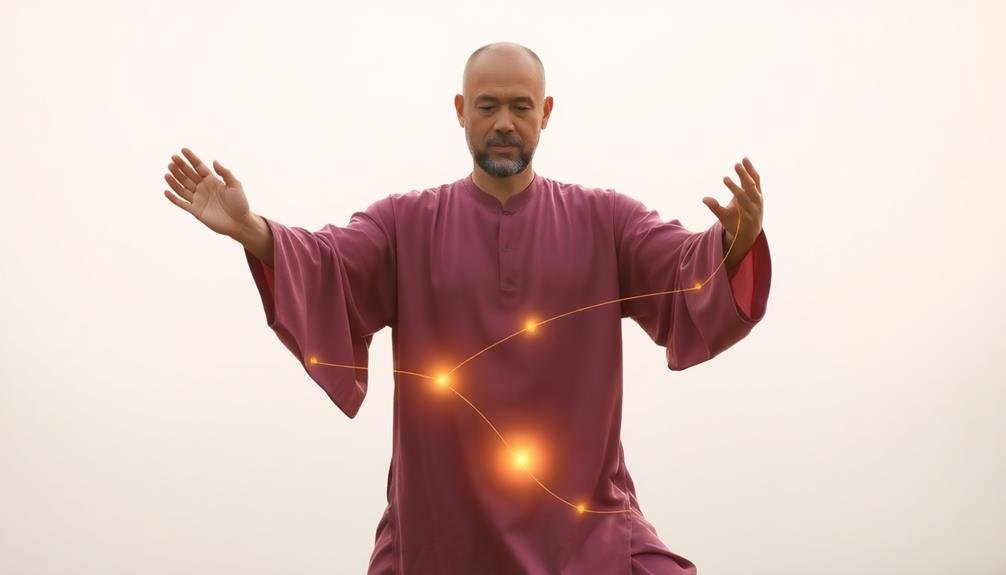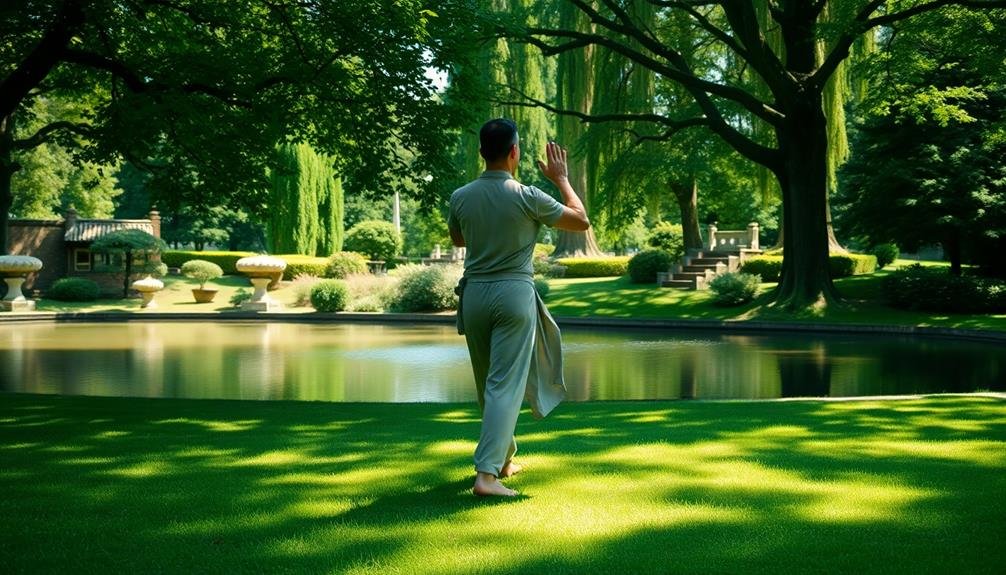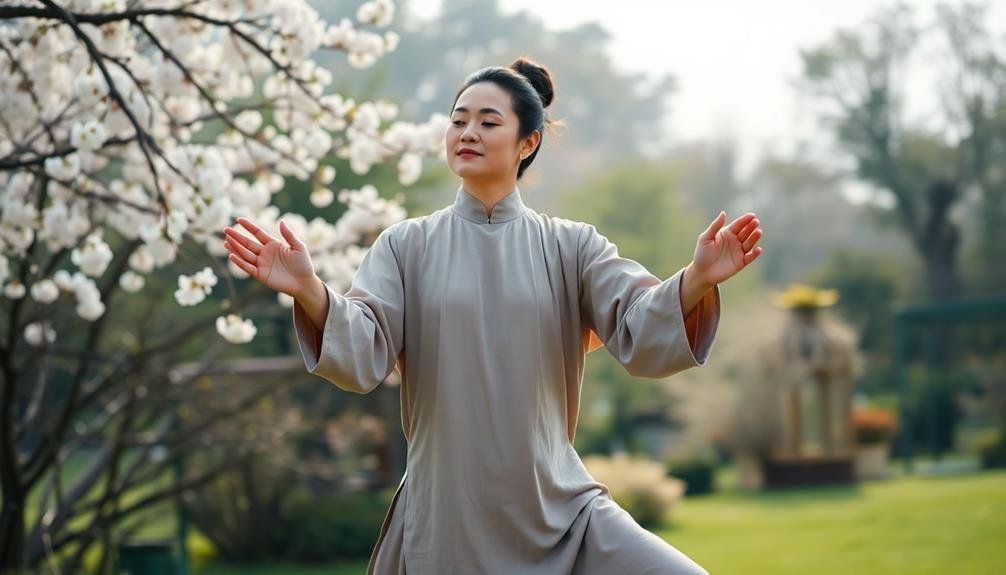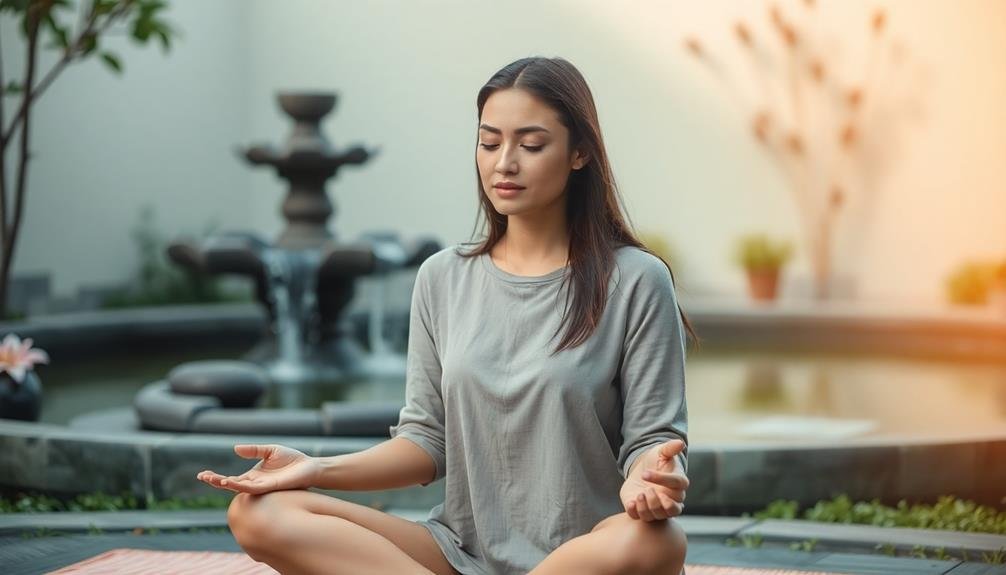Qigong offers powerful, expert-backed techniques to tame anxiety through ancient Chinese practices. You'll learn to balance your body's energy with gentle movements, focused breathing, and meditation. Start with breath awareness exercises like diaphragmatic breathing and visualization. Ground yourself using rooted tree imagery and body scanning. Practice energy circulation with slow, intentional movements along meridians. Incorporate mindful sequences like the Eight Brocades or Five Animal Frolics. Try sound healing, self-massage, and specific meditation techniques to release emotions and reduce tension. By integrating these practices into your daily life, you'll develop a robust toolkit for managing anxiety and cultivating inner peace.
Understanding Qigong and Anxiety

In light of the growing interest in holistic health practices, Qigong has emerged as a powerful tool for managing anxiety. This ancient Chinese practice combines gentle movements, breathing techniques, and meditation to promote physical and mental well-being. Qigong works by balancing your body's energy, or "qi," which can become disrupted during periods of stress and anxiety.
Anxiety is a common mental health condition characterized by excessive worry, fear, and unease. It can manifest physically through symptoms like rapid heartbeat, sweating, and muscle tension. Qigong addresses anxiety by focusing on the mind-body connection, helping you become more aware of your thoughts and physical sensations.
Through regular practice, you'll learn to calm your nervous system and regulate your emotional responses.
The beauty of Qigong lies in its accessibility and versatility. You don't need special equipment or a high fitness level to start. Whether you're dealing with occasional stress or chronic anxiety, Qigong offers a range of techniques that can be tailored to your needs.
Breath Awareness Exercises
Begin your breath awareness practice with diaphragmatic breathing, focusing on expanding your belly as you inhale.
You can enhance your technique by counting breath cycles, typically inhaling for four counts and exhaling for six.
As you breathe, try visualizing calming imagery like a peaceful beach or serene forest to further reduce anxiety.
Diaphragmatic Breathing Technique
Diaphragmatic breathing, often called belly breathing, forms the cornerstone of many Qigong practices for anxiety relief. This technique focuses on deep, intentional breaths that engage your diaphragm, promoting relaxation and reducing stress.
To practice diaphragmatic breathing, find a comfortable position, either sitting or lying down. Place one hand on your chest and the other on your belly. As you breathe, concentrate on expanding your belly rather than your chest. Inhale slowly through your nose, feeling your stomach rise, then exhale through your mouth, allowing your belly to fall. Aim for a natural, relaxed rhythm without forcing the breath.
Regular practice can help you:
- Lower heart rate and blood pressure
- Reduce muscle tension
- Improve oxygen flow throughout your body
- Activate the body's relaxation response
- Increase focus and mental clarity
Start with short sessions of 5-10 minutes and gradually increase the duration as you become more comfortable. You can practice diaphragmatic breathing anytime, anywhere, making it a versatile tool for managing anxiety in various situations.
Counting Breath Cycles
Breath awareness exercises, like counting breath cycles, offer a simple yet effective way to focus your mind and reduce anxiety. This technique involves counting your breaths in a structured manner, helping you stay present and calm.
To practice counting breath cycles, find a comfortable seated position and close your eyes. Begin by inhaling slowly through your nose for a count of four. Hold your breath briefly, then exhale through your mouth for a count of four. This completes one breath cycle. Count each cycle, aiming to reach a specific number, such as 10 or 20.
If your mind wanders, gently bring your attention back to your breath and continue counting where you left off. Don't worry if you lose track; simply start over from one.
As you become more skilled, you can increase the duration of each breath or the number of cycles you count. Regular practice of this technique can improve your ability to manage stress and anxiety.
It's a portable tool you can use anytime, anywhere, to quickly center yourself and regain emotional balance. Try incorporating counting breath cycles into your daily routine for maximum benefits.
Visualizing Calming Imagery
While counting breath cycles focuses on numbers, visualizing calming imagery adds a creative dimension to breath awareness exercises. This technique combines deep breathing with mental imagery to promote relaxation and reduce anxiety. As you inhale and exhale, picture a serene scene or peaceful object in your mind's eye.
Choose imagery that resonates with you personally. Some effective options include:
- A tranquil beach with gentle waves
- A lush, green forest with sunlight filtering through the trees
- A cozy cabin nestled in snowy mountains
- A blooming flower garden with vibrant colors
- A calm lake reflecting a clear blue sky
As you breathe, immerse yourself in the details of your chosen image. Notice the colors, textures, sounds, and even smells associated with the scene. With each inhale, imagine drawing in the calm energy of your visualization.
As you exhale, picture releasing tension and worry. This practice not only helps regulate your breath but also engages your mind, preventing anxious thoughts from taking hold.
Grounding Techniques for Calm

Grounding techniques in Qigong offer powerful tools for calming anxiety. These practices help you reconnect with your body and the present moment, effectively reducing stress and worry.
One simple yet effective technique is the "rooted tree" visualization. Stand with your feet shoulder-width apart, imagining roots growing from your soles deep into the earth. Feel the stability and strength this connection provides, allowing tension to drain away.
Another grounding method involves focusing on your breath while performing gentle Qigong movements. As you inhale, raise your arms slowly; as you exhale, lower them. Concentrate on the sensations in your body and the air moving in and out of your lungs. This practice anchors you to the present, distracting your mind from anxious thoughts.
You can also try the "scanning" technique. Start at your toes and gradually move your attention upward, noticing each part of your body. This heightened awareness helps you identify areas of tension and consciously relax them.
Energy Circulation Practices
Energy circulation practices form a core component of Qigong for anxiety relief.
You'll learn to move chi through your body's meridians, enhancing the flow of essential energy.
Moving Chi Through Meridians
Moving chi through meridians is a fundamental aspect of qigong practice for anxiety relief. By focusing on these energy pathways, you're able to balance your body's energy flow and reduce anxious feelings. To effectively move chi through meridians, you'll need to combine gentle movements, focused breathing, and visualization techniques.
Here are five key points to remember when practicing meridian-based qigong:
- Identify the major meridians in your body, including the lung, heart, and kidney channels.
- Use slow, deliberate movements to stimulate specific meridian points.
- Coordinate your breath with each movement to enhance energy flow.
- Visualize the chi moving through your body as you practice.
- Pay attention to any sensations or changes you feel during and after the exercise.
As you become more familiar with meridian-based qigong, you'll start to notice improvements in your overall well-being.
Regular practice can help reduce anxiety symptoms, improve sleep quality, and boost your immune system.
Remember to be patient with yourself as you learn these techniques, and don't hesitate to seek guidance from a qualified qigong instructor to refine your practice and maximize its anxiety-reducing benefits.
Clearing Energy Blockages
While moving chi through meridians is fundamental, clearing energy blockages takes your qigong practice to the next level. Energy blockages can disrupt your body's natural flow, leading to physical and emotional imbalances. To clear these blockages, you'll need to focus on specific techniques that target areas of stagnation.
Start by identifying where you feel tension or discomfort in your body. These are often indicators of energy blockages. Use gentle tapping, massage, or visualization techniques to break up the stagnant energy. As you practice, you may feel a tingling sensation or warmth spreading through the affected area.
Here's a quick guide to common blockage areas and clearing techniques:
| Body Area | Blockage Symptoms | Clearing Technique |
|---|---|---|
| Head | Headaches, foggy thinking | Temple massage |
| Chest | Anxiety, shallow breathing | Deep chest breaths |
| Solar Plexus | Digestive issues, stress | Abdominal massage |
| Hips | Lower back pain, stiffness | Hip circles |
| Feet | Fatigue, poor circulation | Foot rolling |
Mindful Movement Sequences

Gentle, flowing movements form the core of Qigong's mindful sequences. These carefully choreographed routines combine physical postures, breath control, and mental focus to promote relaxation and reduce anxiety.
As you practice these sequences, you'll find yourself becoming more attuned to your body's sensations and energy flow.
To get started with mindful movement sequences, try incorporating these fundamental Qigong practices:
- Standing meditation (Zhan Zhuang)
- Eight Brocades (Ba Duan Jin)
- Five Animal Frolics (Wu Qin Xi)
- Taiji Qigong Shibashi
- Self-massage techniques
Begin by learning one sequence at a time, focusing on proper form and breathing. As you become more comfortable, you can combine different movements or create your own personalized routine.
Remember to move slowly and deliberately, allowing your breath to guide each motion. Pay attention to how your body feels during and after the practice, noting any changes in tension or energy levels.
Regular practice of these mindful movement sequences can help calm your nervous system, improve body awareness, and cultivate a sense of inner peace.
You'll likely find that these gentle exercises become a powerful tool in managing anxiety and promoting overall well-being.
Visualizations for Inner Peace
Visualizations can be powerful tools in your qigong practice for reducing anxiety.
You can start by imagining a peaceful landscape, such as a serene beach or tranquil forest, allowing your mind to fully immerse in the calming environment.
Another effective technique is the calming light visualization, where you picture a soothing light enveloping your body, gradually relaxing each muscle group as it spreads.
Peaceful Landscape Imagination
As you explore the practice of peaceful landscape imagination, you'll discover a powerful tool for cultivating inner peace. This visualization technique allows you to create a serene mental environment, providing a refuge from anxiety and stress.
Begin by finding a quiet space and settling into a comfortable position. Close your eyes and take a few deep breaths to center yourself.
Now, imagine a tranquil landscape that resonates with you. It could be:
- A secluded beach with gentle waves lapping at the shore
- A lush forest with sunlight filtering through the leaves
- A serene mountain meadow filled with wildflowers
- A peaceful garden with a bubbling fountain
- A calm lake surrounded by towering trees
Engage all your senses as you build this mental image. Feel the warmth of the sun on your skin, hear the soothing sounds of nature, and smell the fresh air.
As you immerse yourself in this peaceful setting, allow tension to melt away from your body and mind. Practice this visualization regularly to create a powerful mental sanctuary you can access whenever anxiety strikes.
Calming Light Visualization
Building on the concept of visualization for inner peace, the calming light technique offers another powerful tool for managing anxiety. This practice involves imagining a soothing, healing light enveloping your body and mind.
To begin, sit comfortably and close your eyes. Take a few deep breaths to center yourself. Visualize a warm, gentle light above your head. It can be any color that feels calming to you – perhaps a soft gold, serene blue, or tranquil green.
Imagine this light slowly descending, touching the top of your head. Feel its warmth and comfort as it gradually flows down your body.
As the light moves, picture it dissolving tension in each area it touches. Let it flow through your face, neck, shoulders, chest, arms, torso, legs, and feet.
With each breath, imagine the light growing stronger, filling your entire being with peace and tranquility. Visualize the light pushing out any anxiety or stress, replacing it with a sense of calm and well-being.
Practice this technique for 5-10 minutes daily to enhance its effectiveness in managing anxiety.
Emotional Release Through Qigong

Through the practice of Qigong, you can unfasten powerful techniques for emotional release. This ancient Chinese practice combines gentle movements, breath work, and meditation to help you process and release pent-up emotions, reducing anxiety and stress.
To harness emotional release through Qigong, try these expert-backed strategies:
- Shaking: Stand with your feet shoulder-width apart and shake your entire body vigorously for 2-3 minutes, allowing tension to dissipate.
- Sound healing: Make deep, resonant sounds like "Ahhh" or "Ommm" while exhaling to release emotional blockages.
- Tapping: Gently tap specific acupressure points on your body while focusing on releasing negative emotions.
- Emotional expression poses: Hold poses that embody certain emotions, then release them with exhalation.
- Mindful breathing: Practice deep, diaphragmatic breathing while visualizing negative emotions leaving your body.
As you engage in these techniques, you'll notice a gradual shift in your emotional state.
Remember, consistency is key. Incorporate these practices into your daily routine for maximum benefit.
Sound Healing in Qigong
Sound healing forms a powerful component of Qigong practice, harnessing the vibrational energy of specific tones to promote emotional and physical well-being. When you're feeling anxious, incorporating sound healing techniques can help you restore balance and calm.
In Qigong, you'll often use six healing sounds: "xu," "he," "hu," "si," "chui," and "xi." Each sound corresponds to a specific organ and emotion.
To practice, find a quiet space and sit comfortably. As you exhale, vocalize the chosen sound, focusing on its vibration in your body. For anxiety relief, try the "xu" sound, associated with the liver and releasing anger. Inhale deeply, then exhale slowly while making a gentle "shuuuu" sound. Repeat this process several times, visualizing tension leaving your body with each exhale.
You can also experiment with humming or chanting "om." These practices stimulate your vagus nerve, triggering your body's relaxation response.
As you become more familiar with sound healing, you'll likely notice a decrease in anxiety symptoms and an overall sense of tranquility. Remember, consistency is key – incorporate these techniques into your daily routine for maximum benefit.
Self-Massage for Anxiety Relief

While sound healing offers powerful anxiety relief through vibration, self-massage provides a tactile approach to calming your nerves. In Qigong, self-massage techniques target specific acupressure points and energy meridians to release tension and promote relaxation.
You'll find these simple yet effective methods easy to incorporate into your daily routine, whether you're at home, work, or on the go.
To practice self-massage for anxiety relief, try these Qigong-inspired techniques:
- Circular temple massage: Using your fingertips, gently rub your temples in small circles
- Ear rub: Massage your ears from top to bottom, focusing on the outer edges
- Neck and shoulder kneading: Apply pressure to tense areas using your fingertips or palms
- Acupressure point stimulation: Press the point between your eyebrows for 30 seconds
- Palm and finger massage: Rub your palms together, then massage each finger individually
As you perform these self-massage techniques, focus on your breath and visualize tension leaving your body.
You'll likely notice an immediate sense of calm and centeredness. With regular practice, you'll develop a greater awareness of your body's stress signals and learn to address them proactively through touch.
Qigong Meditation Techniques
Qigong meditation techniques offer a powerful way to calm your mind and reduce anxiety. These practices combine gentle movements, controlled breathing, and focused intention to promote relaxation and balance.
One effective technique is the "Inner Smile" meditation, where you visualize a warm, healing light spreading through your body, releasing tension and promoting positivity.
Another useful method is the "Cosmic Sound" meditation, which involves making specific sounds while focusing on different energy centers in your body. This practice can help clear negative emotions and restore harmony.
The "Standing Meditation" or "Zhan Zhuang" is a simple yet potent technique where you maintain a static posture while cultivating awareness of your body and breath.
For anxiety relief, try the "Shaking the Tree" exercise, which involves gently shaking your body to release pent-up stress and tension.
Finally, the "Six Healing Sounds" practice pairs specific sounds with breathing exercises to balance your internal organs and emotions.
Integrating Qigong Into Daily Life

Incorporating Qigong into your daily routine doesn't have to be complicated or time-consuming. You can start by dedicating just a few minutes each day to practice simple Qigong exercises. Choose a consistent time, such as right after waking up or before bed, to establish a habit.
To seamlessly integrate Qigong into your life, try these strategies:
- Perform standing meditation while waiting in line or for public transport
- Practice deep breathing exercises during work breaks
- Incorporate gentle Qigong movements into your stretching routine
- Use visualization techniques while commuting or during downtime
- Set reminders on your phone to practice short Qigong sessions throughout the day
As you become more comfortable with Qigong, gradually increase the duration and frequency of your practice. Remember, consistency is key.
Even short, regular sessions can yield significant benefits for managing anxiety. You can also combine Qigong with other activities you enjoy, such as walking in nature or listening to calming music.
Frequently Asked Questions
How Long Does It Take to See Results From Practicing Qigong for Anxiety?
You'll likely notice some immediate relaxation effects from qigong. However, for significant anxiety reduction, practice consistently for 4-8 weeks. Everyone's different, so your results may vary. Stay committed and patient to see the best outcomes.
Can Qigong Be Practiced Alongside Conventional Anxiety Treatments or Medications?
Yes, you can practice qigong alongside conventional anxiety treatments and medications. It's often used as a complementary therapy. Always inform your healthcare provider about your qigong practice to make certain it doesn't interfere with your current treatment plan.
Are There Any Potential Side Effects or Risks Associated With Qigong Practice?
You'll find qigong generally safe, but there are a few potential risks. You might experience dizziness, muscle soreness, or fatigue. If you have existing health conditions, it's best to consult your doctor before starting any new exercise regimen.
Is Qigong Suitable for Children or Teenagers Experiencing Anxiety?
Yes, qigong can be suitable for children and teenagers with anxiety. You'll find it's a gentle, non-invasive practice that can help them manage stress. It's important to choose age-appropriate exercises and have proper guidance for young practitioners.
How Does Qigong Compare to Other Mindfulness Practices for Managing Anxiety?
You'll find qigong offers unique benefits compared to other mindfulness practices. It combines movement, breath, and meditation, which can be more engaging. It's also adaptable, making it suitable for various ages and fitness levels.
In Summary
You've now explored powerful Qigong techniques to manage anxiety. By incorporating breath awareness, grounding exercises, energy practices, mindful movements, sound healing, self-massage, and meditation into your daily routine, you're equipped to cultivate inner calm. Remember, consistency is key. Start small, be patient with yourself, and gradually increase your practice. As you integrate these expert-backed strategies, you'll likely find yourself better able to navigate life's challenges with greater ease and resilience.





Leave a Reply